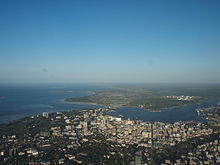|
National Social Security Fund (Tanzania)
The National Social Security Fund (NSSF) is the government agency of Tanzania responsible for the collection, safekeeping, responsible investment, and distribution of retirement funds of all employees in all sectors of the Tanzania economy that do not fall under the governmental pension schemes. The headquartersare located in Kivukoni ward of Ilala District of Dar es Salaam Region. There are one other pension fund organizations in the country; the Public Services Social Security(PSSSF). Fund for all employees working directly under the government and for all employees working under governmental Parastatal organization[3][4] The NSSF was founded in 1997 as the successor to the defunct National Provident Fund (NPF). NSSF covers all other employers in the country and participation for both employers and employees is compulsory. NSSF is both a pension fund and a provident fund.[5] HistoryThe social security scheme dates back to 1945 where all social security issues were handled by the NPF. The National Provident Fund Act was enacted in 1964[6] and amended in 1968.[citation needed] The NPF became defunct in 1997 and the Act of Parliament No. 28 of 1997 replaced the NPF with the NSSF.[7] Corporate affairsManagement and ownershipThe company is entirely owned by the government of Tanzania and is one of the four social security funds in the country. The others are the Parastatal Pension Fund, the Public Service Pensions Fund, and the Local Authority Pension Fund.[8][unreliable source?] All the funds formerly were limited to separate sectors of the workforce; however, the regulations were liberalized in the early 2000s with all funds being authorized to enroll any employees in the formal and informal sector.[4] Board membersThe NSSF is managed by a board of twelve members, not including the director general. All board members must be Tanzanian nationals, and none of the board members may hold executive positions. The board has three specialized committees to manage operations: the Finance and Investment Committee, the Audit Committee, and the Staff Committee.[2] Business trends
A majority of NSSF's revenue comes from employee and employer contributions. The program is a compulsory scheme and is financed with a contribution of 20 percent of employees' salaries, with half of that paid by employers and the other half paid by employees. The key trends for NSSF for 2007-2011 are shown below (as at year ending 30 June):
HeadquartersThe NSSF head office is at the Benjamin Mkapa Pension Towers in Dar es Salaam. The building formerly was named the Mafuta House. NSSF has an office in all major cities and all regional capitals. InvestmentsInvestment portfolioComposition of NSSF Investment Portfolio as at 30 June 2011 Loans (37%) Government Securities (22%) Real Estate (21%) Fixed Deposits (13%) Equity (7%)
The NSSF's investment policy requires the fund to invest 75 percent of its total annual sources. The fund traditionally invests in government securities, fixed deposits, corporate bonds, loans, equities, and real estate. Most of the investments are in loans and government securities and a large percentage of the income comes from interest collections. Recently, the NSSF has begun to invest heavily in real estate and have undertaken multi-billion shillings construction projects in various parts of the country. NSSF Investment Portfolio 2006/07 – 2010/11[2]
Major Real-estate ProjectsNyerere Bridge Nyerere Bridge was built as a joint venture between the Government of Tanzania (40%) and the National Social Security Fund (60%). The Bridge is 680m long and connects the Kurasini in Dar es Salaam to Kigamboni. It was opened to the public in April 2016. Dege Eco VillageDege Eco Village was one of the largest investment projects conducted jointly by NSSF and Azimio Estate Housing Limited. The satellite township is located in the Kigamboni area and covers an area of about 350 acres. The state-of-the-art estate was slated for completion in 2017, however, due to fraud in the giant project,[11][12] construction stopped in 2016. NSSF put the unfinished project up for sale in 2022[13] but as of 2024 it remains abandoned. References
External links |
||||||||||||||||||||||||||||||||||||||||||||||||||||||||||||||||||||||||||||||||||||||||||||||||||||||||||||||||||||
Portal di Ensiklopedia Dunia


